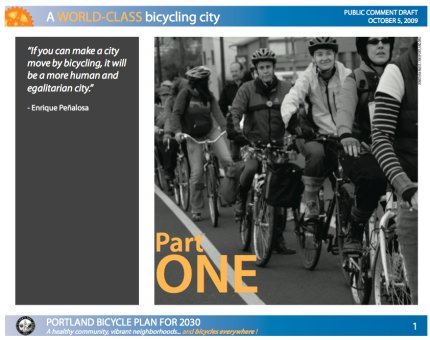
The City of Portland Bureau of Transportation has released a public comment draft of their Portland Bicycle Plan for 2030 and from now until November 8th, they want your input on it.
The public comment draft is the result of hours of hard work and numerous meetings by the Bicycle Master Plan Steering Committee, working in cooperation with the Technical Advisory Committee. Under guidance of the Steering Committee, 11 working groups helped focus on specific topics within the plan. The working groups studied everything from mountain bike trails and health/equity, to bike parking and enforcement policy.
The City’s existing bike plan was adopted in 1996. Since that time, the bikeway network has doubled in total mileage and bike use has skyrocketed.
In a statement about the public comment draft release, the City said the plan,
“positions Portland to support climate action goals and address many of the 21st-century challenges we face by further growing bicycle transportation. The new plan proposes fundamental changes to city policy, implementation of new street designs, a much expanded bicycle transportation network, and an array of supporting actions and programs.”
The Portland Planning Commission is set to hold a hearing on the plan later this month and it is (tentatively) scheduled for a City Council hearing in January.
Review the Public Comment Draft of the Portland Bicycle Plan for 2030 here.
Comments are due by November 8th and should be directed to:
- Ellen Vanderslice, PBP Project Manager
Portland Bureau of Transportation
1120 SW 5th Avenue, Suite 800
Portland, Oregon 97204
E-mail: bicyclemasterplan@pdxtrans.org
Stay tuned to BikePortland for more coverage of the Portland Bicycle Plan. See all our previous coverage at the Portland Bicycle Plan special section page.


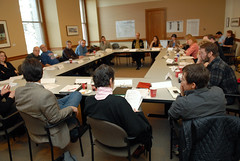
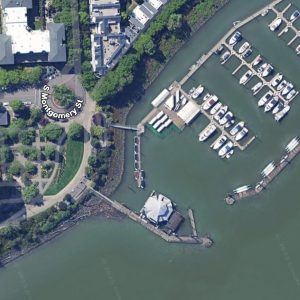

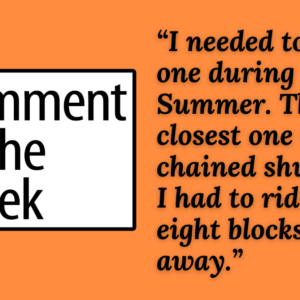
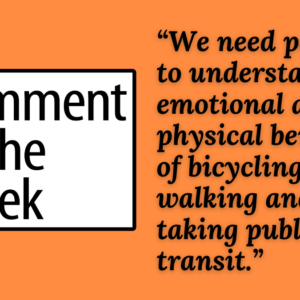
Thanks for reading.
BikePortland has served this community with independent community journalism since 2005. We rely on subscriptions from readers like you to survive. Your financial support is vital in keeping this valuable resource alive and well.
Please subscribe today to strengthen and expand our work.
The Bikeway Design Best Practices PDF is awesome. What a comprehensive and handy compilation of bicycle facility best practices.
okay, I have read it. and I will admit that I was reading with an eye for finding fault. specifically, the predisposition toward sidepaths. and there are a couple of places in the report, which I will get to in a moment.
but first I will note that the discussion of bike boulevards does acknowledge that these “emphasize comfort and safety over immediate access to commercial destinations,” and that there is a need to connect these up to main streets and “other commercial nodes.” so at least we are not in complete denial here. they even acknowledge that portland is “not yet” copenhagen.
okay, so on to the negativity.
one quarrel I have is with 3.2.5, where they say they want “separated in-roadway bikeways” (read, striped lanes, buffered lanes, cycletracks) “where motor vehicle traffic volumes or speeds are high,” and 3.2.6, where they say it’s okay to do signage and sharrows (non-“separated”) on “lower volume roadways.”
the problem here is that if you push cyclists off to the side on highly trafficked roads, you will have closer passing distances than if cyclists are permitted to take the lane.
(on buffered lanes or cycletracks, the problem is conflicts at intersections, where the cyclist has to come out of the segregated facility)
similarly, at 3.8.1, they say the central city “should be an ideal place to ride a bike,” in part because of the shorter blocks (not conducive to segregated facilities) and lower speeds, but then they conclude that they need to take “significant actions” to improve safety, and cite unspecified “best practices” from “other world-class bicycling cities” as supporting “the importance of creating separation, whenever practical, between bicyclists and motorists.”
no surprises, I guess, but how is anyone supposed to resist the inevitability here? create all the facilities you want for the “sense of safety and comfort” of the less assertive cyclist. even without the bike boulevard designation, I will often choose a quieter street with less exhaust fumes. but when I get out on the main road, don’t put down a stripe or a segregated facility, unless (a) you are going to repeal the mandatory sidepath law and (b) you are going to educate motorists that the sidepath is for the convenience of some, but is not mandatory for all, so slow down and share the road.
I would imagine that, without adequate funding, or city council and public support, very little of these proposed projects are ever going to get built. How many of the last bike master plan’s tough projects (e.g. Hawthorne Blvd.) ever actually got built? And by and large they were less expensive and less ambitious projects than the projects proposed in this plan.
I also think that PDOT is gravely underestimating the risks of negative motorist-bicyclist interactions at intersections that will almost certainly occur at many locations with the proliferation of proposed separated facilities.
And I agree that repeal of the mandatory bike lane/sidepath law (ORS 814.420) is essential to achieving broad support for the plan in the ‘cycling community’.
I also see some glaring omissions, such as SE Stark, already a fairly good lower traffic route that could use some simple enhancements.
Finally, I wonder how much consideration was given to topography in addition to traffic volumes when selecting proposed routes.
If the city and their consultants ( Alta Planning ) really wanted to make the plan better with public comment, they would publish the individual pages with a place to make comments and vote on ideas.
I don’t think they want the public to be able to dialog. They want the model of send them your comments, and they will decide what comments are worthy.
I’d also like to see the costs of each part of the plan. I do not want to see money wasted on those proposed metal “art” bikes to mark Clinton St. I’d rather spend the money on barriers that let bikes go straight on bike boulevards, and make cars divert every few blocks.
Anyone have ideas on how we can get the city to let users see and share comments on each page of the plan? We could convert it from PDF to DOC then upload to a shared google docs. People could add comments rather than edit the text.
If we cannot get the City to proactively invest, at what point does the sheer percentage of people using this mode of transportation beget forking over a commensurate portion of the transportation budget. We’ve put the “gas tax” myth to rest (I hope), so when will we see real equity for the general tax dollars . . . much less the kind of investments we see in rail (which can never “pencil out” compared to bikes)?
Well-stated points, all. I assume that you’ll be sending them in as comments to Ellen Vanderslice at PBOT and not just bikeportland.org, right?
From my perspective, I think it looks great. Fund it, Sam!
I think it’s almost pointless to submit comments to the city. It’s obvious from the make up of the committee and the focus of the plan that they have already made up their minds and if you are not in lockstep with them, you’re voice won’t be heard and your opinion won’t be considered. I’ve spent enough time on various transportation advisory committees already to know that this is how the city operates.
BURR #4 –
“I also see some glaring omissions, such as SE Stark, already a fairly good lower traffic route that could use some simple enhancements.”
please elaborate, I’m curious what these enhancements would be..?
Sharrows on SE Stark would be a good start
I am very disappointed in the draft Bike Master Plan.
First and foremost it totally ignores the work done by Alta Planning a few years ago for the Swan Island TMA, the Swan Island Trails Action Plan, which calls for above (or behind) the curb bike/ped facilities throughout that area, including the Willamette Greenway Trail along Basin, Lagoon, Ballast and Channel. Indeed, we just built the Channel section (it looks great!), and the Plan shows a future “in street” facility. Did anyone from staff even look at the Action Plan? No one asked the Swan Island TMA what works for bike commuters on Swan Island.
Likewise, the Plan totally ignores the existing (though substandard) Going street sidewalk (Going to the River) which as I write is being upgraded to 10′ with a crash barrier over the UPRR tracks. The Plan is totally disconnected from reality on Swan Island, where heavy truck traffic makes in street facilities non starters. Swan Island isn’t even on PBOT’s bike analysis map as though 10,000 people don’t work here, including the largest manufacturing employer in the City that just made the Top Ten in the latest BCC. PBOT bike counts failed to register the bike commuters using Going to the River or the Waud Bluff path.
That aside, the Plan lacks any “signature” transformative projects like the Eastbank Esplanade or Springwater on the Willamette.
These kind of projects are expensive and require vision. Willamette Greenway Trail is just such a project that should be on the cover of the Bike Plan, not in Tier 2 for development in 20 years. Just as the transit system needs the MAX network, so bike/ped access needs a Trail network.
Bike “boulevards” in Portland, I am sorry to say, are a joke…with little dots, a couple of signs and a line on the map, nothing more. As a member of the Tillamook bikeway CAC, I have felt nothing but disappointment over the years as the City failed to properly sign that facility and control motorized vehicle traffic. It is hardly a Bike Boulevard, and PBOT does that concept a disservice to attach that name to what we have in Portland. Portland has NO true Bike Boulevards.
Again, Willamette Greenway Trail needs to be elevated to the status of next big thing for Active Transport in Portland.
Lenny Anderson, Project Manager, Swan Island TMA “moving freight by creating and promoting transportation options for Swan Island’s 10,000 employees”
and NE Portland resident